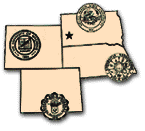Animal Science, Department of

Range Beef Cow Symposium
Date of this Version
December 1995
Document Type
Article
Abstract
Thank you for the invitation to participate in the Range Beef Cow Symposium XIV. I have attended some of the Symposia over the years and have found them all to be very informative and educational. I congratulate the staff of the four Universities for the contribution they give to the Beef Industry.
My family has a grain and livestock operation in western South Dakota. My wife and I have four sons, who are all involved in our operation.
Developing a cow herd that will produce specific, predictable and on-time off-spring, has always been a challenge for most ranchers.
Buying feeder cattle for our family feedlot operation, that are specific, predictable and uniform in size and weight is just as big of a challenge.
We have always raised commercial replacement heifers and sold part of them at a bred heifer sale. We would pasture breed for 45 days to low birth weight bulls. We would preg test and sell them as a 45 day calving period package.
In 1982, we started a small feedlot and over the years have increased it to a total capacity of 10,000 head. During these years we have been tracking several groups of different ranchers cattle. One of the results that keep showing up is the inconsistency of performance and carcass value within a single rancher herd.
Five years ago we began a partner feeding arrangement with Seidel, Inc. (Ron Seidel) of Bison who backgrounds calves up to 800 lbs. then brings them to our feedlot to finish. Seidel was finding some of the same inconsistency in his operation.
After a lot of discussion we decided to pursue an A.I. commercial heifer program to sell to ranchers who prefer to buy their replacement heifers rather than raise them.


Comments
Published for Proceedings, The Range Beef Cow Symposium XIV December 5, 6 and 7, 1995, Gering, Nebraska.